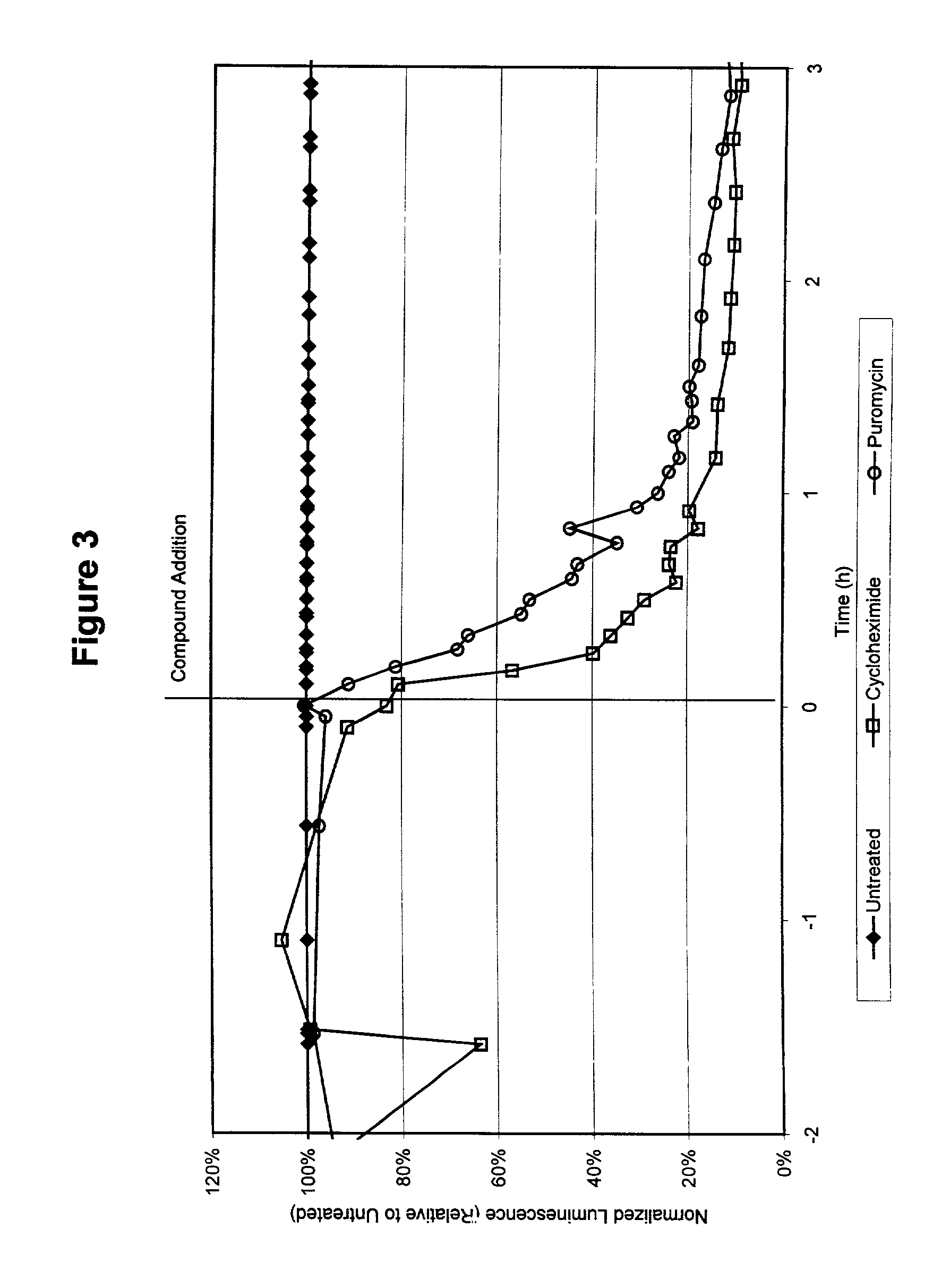Compounds to co-localize luminophores with luminescent proteins
a technology of luminescent proteins and compounds, applied in the direction of instruments, chemical methods analysis, analysis using chemical indicators, etc., can solve the problems of reducing the ability to measure accurately the quantity of light, limiting the usefulness of an analytical assay, and short-lived luminescent signals
- Summary
- Abstract
- Description
- Claims
- Application Information
AI Technical Summary
Benefits of technology
Problems solved by technology
Method used
Image
Examples
examples
[0087]All solvents and reagents were obtained from FISHER SCIENTIFIC except as follows. Mathew's Buffer was assembled from the following, obtained from SIGMA CHEMICALS: 100 mM potassium phosphate buffer, pH 7.4; 500 mM sodium chloride; 1 mM ethylenediamine tetraacetic acid (EDTA); and 0.1% w:v Gelatin Type A (75-100 Bloom). Ham's F12 medium and fetal bovine serum were obtained from LIFE TECHNOLOGIES, Rabbit esterase was obtained from SIGMA CHEMICALS, and Renilla luciferase was obtained from CHEMICON CORP.
example no.1
Example No. 1
[0088]In this example, a protected luminophore bearing three acetyl protecting groups was synthesized from a coelenterazine having the structure VI. To a solution of compound VI (STOP AND GLO® SUBSTRATE, PROMEGA CORPORATION) (500 mg; 1.2 mM) in anhydrous pyridine (20 ml) was added acetic anhydride (1.1 ml; 12 mM), and the reaction was kept under an inert atmosphere at room temperature. After 1 hour, 30 ml of CH2Cl2 was added to the reaction, followed by 80 ml H2O. This mixture was stirred for 5 minutes, and then the layers were separated. The organic layer was evaporated to dryness and then purified by column chromatography as follows. Normal phase silica (20 g) was solvated in CH2Cl2 and loaded into an appropriate sized glass column. The extracted reaction mixture was taken up in a minimum of CH2Cl2 and applied to the top of the column. A step gradient was employed, starting at 1% ethyl acetate (EtOAc) in CH2Cl2 and increasing in polarity until the desired compound elu...
example no.2
Example No. 2
[0089]In this example, a protected luminophore bearing three butyryl protecting groups was synthesized from a coelenterazine having the structure VI. To a solution of compound VI (300 mg; 0.7 mM) in anhydrous pyridine (30 ml) was added butyric anhydride (1.12 g; 7 mM), and the reaction was allowed to sit under an inert atmosphere at room temperature. After 1 hour, the reaction mixture was placed under vacuum in order to remove the solvent until a syrup was formed. To the syrup was added 30 ml CH2Cl2, followed by 80 ml H2O. This mixture was stirred for 5 minutes, and then the layers were separated. The organic layer was then evaporated to dryness and then purified by column chromatography as follows. Normal phase silica (20 g) was solvated with 2% EtOAc in CH2Cl2 and loaded into an appropriate sized glass column. The extracted reaction mixture was taken up in minimum of CH2Cl2 and applied to the top of the column. The mobile phase was isocratic, and all of the desired co...
PUM
| Property | Measurement | Unit |
|---|---|---|
| temperature | aaaaa | aaaaa |
| temperature | aaaaa | aaaaa |
| concentration | aaaaa | aaaaa |
Abstract
Description
Claims
Application Information
 Login to View More
Login to View More - R&D
- Intellectual Property
- Life Sciences
- Materials
- Tech Scout
- Unparalleled Data Quality
- Higher Quality Content
- 60% Fewer Hallucinations
Browse by: Latest US Patents, China's latest patents, Technical Efficacy Thesaurus, Application Domain, Technology Topic, Popular Technical Reports.
© 2025 PatSnap. All rights reserved.Legal|Privacy policy|Modern Slavery Act Transparency Statement|Sitemap|About US| Contact US: help@patsnap.com



